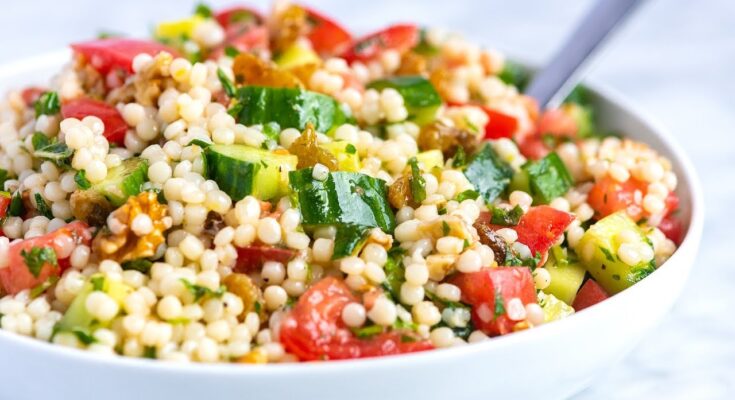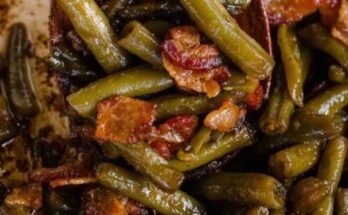Couscous Salad Recipe: Couscous salad is one of those dishes that effortlessly brings together taste, nutrition, and convenience. Light yet filling, this refreshing salad has its origins in North African cuisine but has traveled across the globe and become a favorite in many households. It’s not just another salad—it’s a vibrant bowl of textures and flavors that can be adapted to suit different palates.
Unlike heavy pasta or rice dishes, couscous salad is versatile enough to be enjoyed as a main course, a side dish, or even as a quick lunch on busy weekdays. The beauty of couscous lies in how quickly it cooks—just a few minutes of soaking in hot water, and it’s ready to use. This makes it perfect for anyone who doesn’t want to spend hours in the kitchen but still wants something delicious and healthy.
Another reason couscous salad stands out is its balance. The fluffy couscous grains soak up the flavors of fresh vegetables, herbs, and dressings, making every bite delightful. Whether you enjoy it plain with a lemony dressing or jazz it up with grilled chicken, feta cheese, or roasted chickpeas, there’s a version of couscous salad for everyone.
Why Couscous Salad is a Perfect Choice
Couscous salad ticks all the boxes when it comes to being a practical dish. It’s quick to prepare, budget-friendly, and works for any occasion. Hosting a family gathering? Couscous salad is a crowd-pleaser. Need a meal-prep idea for the week? This salad stores well in the fridge and even tastes better the next day. Planning a summer picnic? It’s light, refreshing, and easy to pack.
Not to mention, couscous salad can easily fit into different diets. Whether you’re vegetarian, vegan, or a meat lover, you can adapt it by switching up the ingredients. You can keep it simple with tomatoes, cucumbers, and parsley or make it hearty with beans, chickpeas, or roasted veggies. Its adaptability is what makes it timeless.
Health Benefits of Couscous Salad
Beyond its great taste, couscous salad is a healthy choice for most people. Couscous itself is a source of complex carbohydrates, giving you steady energy without the crash you get from processed foods. It’s also low in fat and calories, making it a great option if you’re looking to maintain a healthy weight.
The vegetables added to couscous salad bring in fiber, vitamins, and minerals. Cucumbers hydrate, tomatoes provide antioxidants, bell peppers add vitamin C, and parsley boosts freshness with iron and vitamin K. The dressing—often made with olive oil and lemon—adds healthy fats and a zesty punch.
Eating couscous salad regularly can support digestion, improve heart health, and keep you feeling full longer. Plus, when paired with lean protein like grilled chicken or fish, it becomes a balanced, wholesome meal that nourishes both body and mind.
Ingredients You’ll Need for Couscous Salad
Before we dive into the step-by-step guide, let’s take a closer look at the ingredients you’ll need. Having everything ready beforehand makes the process much smoother.
Main Ingredients for the Salad Base
The star of this recipe is couscous, and for this guide, we’ll be using the fine, quick-cooking variety. You’ll need:
- 1 cup couscous
- 1 cup boiling water or vegetable broth
- A pinch of salt
- 1 tablespoon olive oil
This forms the fluffy, golden base of your salad. If you’d like a chewier texture, you can also use pearl couscous (also called Israeli couscous), which has larger grains.
Fresh Vegetables to Add Crunch and Flavor
Vegetables are what make couscous salad vibrant and refreshing. Here are some essentials:
- 1 cucumber (diced)
- 2 medium tomatoes (chopped)
- 1 red bell pepper (diced)
- ½ red onion (finely sliced)
- 1 carrot (grated or julienned)
Feel free to mix and match with whatever you have on hand. Zucchini, corn, or even roasted veggies can work beautifully here.
Herbs and Spices for Extra Taste
Fresh herbs elevate couscous salad to the next level. The combination of parsley and mint gives it a refreshing twist. You’ll need:
- ½ cup fresh parsley (chopped)
- ¼ cup fresh mint (chopped)
- ½ teaspoon black pepper
- ½ teaspoon paprika or cumin (optional, for a little warmth)
Dressing Ingredients for Perfect Balance
The dressing is what ties everything together. A good couscous salad dressing should be tangy, slightly sweet, and refreshing. For this recipe, you’ll need:
- 3 tablespoons olive oil
- 2 tablespoons fresh lemon juice
- 1 teaspoon honey or maple syrup
- 1 clove garlic (minced)
- Salt and pepper to taste
This simple dressing balances the light couscous and fresh veggies perfectly.
Step-by-Step Guide to Making Couscous Salad
Now that you’ve got all your ingredients lined up, let’s go through the cooking process step by step.
Step 1 – Preparing the Couscous
The first step is to cook the couscous, which couldn’t be easier. In a medium bowl, pour one cup of couscous. Add one cup of boiling water or broth, a pinch of salt, and a drizzle of olive oil. Cover the bowl with a lid or plate and let it sit for 5 minutes.
After 5 minutes, uncover the couscous and fluff it with a fork to separate the grains. This step is crucial because it prevents the couscous from becoming clumpy or sticky. Once fluffed, allow it to cool slightly before adding the other ingredients.
Using vegetable broth instead of water is a great trick because it infuses the couscous with extra flavor. If you want more depth, you can even add a bay leaf or a clove of garlic to the broth before pouring it over the couscous.
Step 2 – Chopping the Fresh Vegetables
Once your couscous is cooling down, it’s time to get your vegetables ready. The magic of couscous salad lies in the freshness of its crunchy vegetables. Start with cucumbers—dice them into small, bite-sized pieces. Make sure to keep them uniform in size so that every bite has a balanced texture. Tomatoes should be chopped into small cubes, and if they’re extra juicy, you can scoop out some seeds to prevent your salad from becoming too watery.
Next, take your red bell pepper. Its sweetness and vibrant color add a beautiful contrast to the couscous. Dice it finely so that it blends seamlessly with the rest of the salad. Then move on to the red onion—slice it very thin so it adds a sharp yet subtle kick without overwhelming the dish. Finally, grate or julienne a fresh carrot for added crunch and natural sweetness.
If you like experimenting, you can throw in some extra veggies like corn, zucchini, or even roasted eggplant. Each vegetable brings something unique to the table, making your couscous salad a colorful, nutrient-rich masterpiece. As you chop, place all the vegetables in a large bowl, ready to be combined later.
The key here is balance—too many strong flavors can overpower the couscous, while too few will leave it bland. Stick with this mix, and you’ll get that perfect harmony of taste and texture.
Step 3 – Mixing Herbs and Spices
Herbs and spices are what transform couscous salad from ordinary to extraordinary. Once your vegetables are ready, add the chopped parsley and mint. Fresh parsley gives a clean, earthy flavor, while mint adds a cool, refreshing twist that brightens up every bite. Don’t skip the herbs—they’re the heart of the salad’s flavor profile.
Next, season with black pepper and a pinch of salt. You can also add a dash of paprika or cumin if you’d like a smoky or warm undertone. Some people even like to sprinkle in a little chili powder for a hint of spice. The beauty of this recipe is that you can adjust the spices to suit your personal taste.
Mixing herbs and spices into the vegetables before combining them with couscous ensures that the flavors are evenly distributed. When you finally bring everything together, the couscous will soak up all these delicious seasonings.
If you want to take it a step further, you can lightly toast your spices in a dry pan before adding them to the salad. This technique enhances their aroma and deepens the flavor, making your couscous salad taste like it came straight from a gourmet kitchen.
Step 4 – Preparing the Dressing
No salad is complete without a good dressing, and couscous salad is no exception. A zesty, refreshing dressing ties all the flavors together and makes the dish shine. In a small bowl, whisk together olive oil, fresh lemon juice, honey (or maple syrup for a vegan option), minced garlic, salt, and pepper.
The olive oil provides richness, while lemon juice brings tanginess. Honey or maple syrup balances the acidity, and garlic adds a punch of flavor that gives the salad depth. Taste the dressing before pouring it in—it should be tangy, slightly sweet, and well-seasoned. If it feels too sharp, add a little more olive oil. If it feels too bland, squeeze in a bit more lemon juice or add a pinch of salt.
One trick many chefs use is to make the dressing in a jar with a tight-fitting lid. Just add all the ingredients, close the lid, and shake it vigorously. This method helps emulsify the oil and lemon juice, creating a smooth, well-blended dressing.
You can also experiment with different variations. For a Mediterranean twist, add a teaspoon of Dijon mustard. For a Middle Eastern flavor, sprinkle in some sumac or tahini. These small tweaks can take your couscous salad in exciting new directions.
Step 5 – Combining Everything Together
Now comes the most satisfying part—bringing all the elements together. Take your fluffed couscous and add it to the bowl of chopped vegetables, herbs, and spices. Gently toss everything with a large spoon or fork, making sure the couscous grains don’t clump together.
Next, pour in the dressing. Start with half and mix thoroughly, then taste before adding the rest. This way, you can control the flavor intensity and avoid over-dressing the salad. The couscous will absorb the dressing beautifully, giving it a burst of flavor with every bite.
As you mix, you’ll see the vibrant colors of the vegetables against the golden couscous—it’s not just delicious but also visually stunning. This is why couscous salad often steals the spotlight at dinner tables and picnics.
Once mixed, let the salad sit for about 10 minutes before serving. This resting time allows the couscous to soak up the flavors from the dressing and vegetables, making the dish even more delicious.
If you’re planning to serve it later, cover the bowl with plastic wrap or transfer it to an airtight container and refrigerate. The flavors will continue to develop, and the salad will taste even better the next day.
Tips to Customize Your Couscous Salad
One of the best things about couscous salad is its flexibility. You can make it as simple or as fancy as you like. Think of couscous as a blank canvas—you can paint it with whatever flavors and textures you’re in the mood for. Whether you’re trying to make it a filling dinner, a light lunch, or a show-stopping side dish, customization is the key.
Adding Proteins for a Complete Meal
If you want your couscous salad to go from a light side dish to a full, satisfying meal, adding protein is the way to go. Grilled chicken, shrimp, or salmon work beautifully if you enjoy meat or seafood. For vegetarians and vegans, chickpeas, black beans, or tofu are excellent choices. These not only make the salad more filling but also boost its nutritional value.
Another great option is cheese. Feta, goat cheese, or even halloumi add a creamy, salty flavor that balances out the freshness of the vegetables. If you prefer a dairy-free version, roasted nuts like almonds, walnuts, or cashews can provide crunch and a dose of healthy fats.
By adding protein, your couscous salad transforms into a balanced one-bowl meal that keeps you satisfied for hours.
Vegan and Gluten-Free Variations
Couscous itself is made from wheat, so if you’re following a gluten-free diet, you can swap it with quinoa or millet. Both are excellent alternatives that mimic couscous’s fluffy texture while being naturally gluten-free.
For a vegan version, simply skip any cheese or honey in the dressing. Instead, use maple syrup or agave nectar for sweetness and stick to plant-based proteins like lentils or beans. The beauty of couscous salad is that it’s adaptable to dietary needs without compromising flavor.
Best Seasonal Additions
One easy way to keep couscous salad exciting all year round is to switch up the ingredients based on the season. In summer, fresh tomatoes, cucumbers, and basil are perfect. In autumn, you can add roasted butternut squash, cranberries, and toasted pumpkin seeds. Winter versions can include roasted root vegetables like carrots and beets, while spring calls for fresh peas, asparagus, and herbs.
Seasonal variations not only keep the salad interesting but also ensure you’re using fresh, nutrient-rich produce at its peak flavor.
Serving Suggestions and Storage Tips
Couscous salad is incredibly versatile when it comes to serving. It can shine on its own or complement other dishes perfectly. Plus, it stores really well, making it a great choice for meal prep or parties.
Ideal Side Dishes to Pair With Couscous Salad
Couscous salad pairs beautifully with grilled meats like chicken skewers, lamb chops, or fish. For a vegetarian spread, serve it alongside falafel, hummus, and pita bread for a complete Mediterranean-inspired meal. It’s also a fantastic side dish for barbecues, picnics, and potlucks because it travels well and can be served at room temperature.
If you’re looking for a lighter option, pair it with a simple soup or roasted vegetables. It’s one of those salads that complement almost anything you put on the table.
How to Store and Keep it Fresh
The best thing about couscous salad is that it tastes even better the next day, once the flavors have had time to blend. To store, place it in an airtight container and refrigerate. It will stay fresh for up to 3–4 days.
If you plan to make it ahead of time, keep the dressing separate and toss it in just before serving to maintain the freshness and crunch of the vegetables. This trick ensures the salad doesn’t become soggy.
Make-Ahead Option for Meal Prep
Couscous salad is a meal-prepper’s dream. You can make a big batch on Sunday and portion it into individual containers for the week ahead. Just keep the dressing in a small jar and add it before eating. This way, your salad stays vibrant and crisp all week long.
It’s also great for packed lunches because it doesn’t wilt like lettuce-based salads. Whether you’re taking it to the office, school, or on a road trip, couscous salad remains delicious and refreshing.
FAQs about Couscous Salad Recipe
1. Can I use pearl couscous instead of regular couscous?
Yes, pearl couscous (also called Israeli couscous) can be used, but it has a chewier texture and takes a bit longer to cook. Both versions are delicious, so it’s a matter of preference.
2. How long can couscous salad last in the fridge?
Couscous salad lasts about 3–4 days when stored in an airtight container in the fridge. Just make sure to give it a quick toss before serving.
3. What protein goes best with couscous salad?
Grilled chicken, shrimp, and salmon are fantastic options. For a vegetarian version, chickpeas, beans, or tofu work perfectly.
4. Can I serve couscous salad warm or cold?
You can enjoy it both ways. Traditionally, it’s served chilled or at room temperature, but serving it slightly warm works well, especially in colder months.
5. Is couscous salad suitable for kids?
Absolutely! Its mild flavors, colorful veggies, and soft texture make it appealing to kids. You can adjust the seasonings to make it kid-friendly.
Conclusion
Couscous salad isn’t just a recipe—it’s a lifestyle choice. It’s quick, healthy, adaptable, and bursting with flavor. From the fluffy couscous base to the fresh vegetables, zesty dressing, and optional proteins, this dish offers endless ways to enjoy wholesome food without spending hours in the kitchen.
Whether you’re making it as a side dish for a family dinner, a refreshing meal-prep option, or the star of your picnic basket, couscous salad will never disappoint. Its lightness makes it ideal for warm days, while its versatility keeps it interesting year-round.
So next time you’re in the mood for something easy yet impressive, skip the takeout and whip up a couscous salad. Once you taste the vibrant mix of flavors and textures, it might just become your go-to recipe for all occasions.



